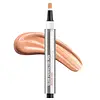What's inside
What's inside
 Key Ingredients
Key Ingredients

 Benefits
Benefits

 Concerns
Concerns

 Ingredients Side-by-side
Ingredients Side-by-side

Water
Skin ConditioningGlycerin
HumectantMethyl Trimethicone
Skin ConditioningHydrogenated Polyisobutene
EmollientDimethicone
EmollientTrimethylsiloxysilicate
EmollientButylene Glycol Dicaprylate/Dicaprate
EmollientPhenyl Trimethicone
Skin ConditioningPentylene Glycol
Skin ConditioningLauryl PEG-10 Tris(Trimethylsiloxy)Silylethyl Dimethicone
EmulsifyingTocopheryl Acetate
AntioxidantIsododecane
EmollientCetyl PEG/PPG-10/1 Dimethicone
EmulsifyingPolyphenylsilsesquioxane
Panthenol
Skin ConditioningMagnesium Sulfate
Silica
AbrasiveDisteardimonium Hectorite
StabilisingDimethicone/Vinyl Dimethicone Crosspolymer
Skin ConditioningTriethoxycaprylylsilane
Aluminum Hydroxide
EmollientCaprylyl Glycol
EmollientGlyceryl Caprylate
EmollientTrisodium Ethylenediamine Disuccinate
Titanium Dioxide
Cosmetic ColorantMica
Cosmetic ColorantIron Oxides
Water, Glycerin, Methyl Trimethicone, Hydrogenated Polyisobutene, Dimethicone, Trimethylsiloxysilicate, Butylene Glycol Dicaprylate/Dicaprate, Phenyl Trimethicone, Pentylene Glycol, Lauryl PEG-10 Tris(Trimethylsiloxy)Silylethyl Dimethicone, Tocopheryl Acetate, Isododecane, Cetyl PEG/PPG-10/1 Dimethicone, Polyphenylsilsesquioxane, Panthenol, Magnesium Sulfate, Silica, Disteardimonium Hectorite, Dimethicone/Vinyl Dimethicone Crosspolymer, Triethoxycaprylylsilane, Aluminum Hydroxide, Caprylyl Glycol, Glyceryl Caprylate, Trisodium Ethylenediamine Disuccinate, Titanium Dioxide, Mica, Iron Oxides
Water
Skin ConditioningButylene Glycol
HumectantTridecyl Trimellitate
EmollientGlycerin
HumectantGlyceryl Stearate Citrate
EmollientSimmondsia Chinensis Seed Oil
EmollientTriethylhexanoin
MaskingMica
Cosmetic ColorantPolyglyceryl-3 Stearate
EmulsifyingPanthenol
Skin ConditioningTetrahexyldecyl Ascorbate
AntioxidantTocopherol
AntioxidantHydrogenated Lecithin
EmulsifyingSqualane
EmollientSodium Hyaluronate
HumectantPropanediol
SolventPhospholipids
Skin ConditioningPolysorbate 60
EmulsifyingSorbitan Isostearate
EmulsifyingEthylene/Propylene/Styrene Copolymer
Butylene/Ethylene/Styrene Copolymer
Xanthan Gum
EmulsifyingGlyceryl Undecylenate
EmollientGlyceryl Caprylate
EmollientHydroxyacetophenone
AntioxidantHydroxyethyl Acrylate/Sodium Acryloyldimethyl Taurate Copolymer
Emulsion StabilisingPhenoxyethanol
PreservativeEthylhexylglycerin
Skin ConditioningTin Oxide
AbrasiveCI 77491
Cosmetic ColorantCI 77891
Cosmetic ColorantWater, Butylene Glycol, Tridecyl Trimellitate, Glycerin, Glyceryl Stearate Citrate, Simmondsia Chinensis Seed Oil, Triethylhexanoin, Mica, Polyglyceryl-3 Stearate, Panthenol, Tetrahexyldecyl Ascorbate, Tocopherol, Hydrogenated Lecithin, Squalane, Sodium Hyaluronate, Propanediol, Phospholipids, Polysorbate 60, Sorbitan Isostearate, Ethylene/Propylene/Styrene Copolymer, Butylene/Ethylene/Styrene Copolymer, Xanthan Gum, Glyceryl Undecylenate, Glyceryl Caprylate, Hydroxyacetophenone, Hydroxyethyl Acrylate/Sodium Acryloyldimethyl Taurate Copolymer, Phenoxyethanol, Ethylhexylglycerin, Tin Oxide, CI 77491, CI 77891
 Reviews
Reviews

Ingredients Explained
These ingredients are found in both products.
Ingredients higher up in an ingredient list are typically present in a larger amount.
Glycerin is already naturally found in your skin. It helps moisturize and protect your skin.
A study from 2016 found glycerin to be more effective as a humectant than AHAs and hyaluronic acid.
As a humectant, it helps the skin stay hydrated by pulling moisture to your skin. The low molecular weight of glycerin allows it to pull moisture into the deeper layers of your skin.
Hydrated skin improves your skin barrier; Your skin barrier helps protect against irritants and bacteria.
Glycerin has also been found to have antimicrobial and antiviral properties. Due to these properties, glycerin is often used in wound and burn treatments.
In cosmetics, glycerin is usually derived from plants such as soybean or palm. However, it can also be sourced from animals, such as tallow or animal fat.
This ingredient is organic, colorless, odorless, and non-toxic.
Glycerin is the name for this ingredient in American English. British English uses Glycerol/Glycerine.
Learn more about GlycerinGlyceryl Caprylate comes from glycerin and caprylic acid, a fatty acid from coconut. It has emollient and emulsifier properties.
As an emollient, it helps hydrate your skin. Emollients work by creating a barrier on your skin to trap moisture in, helping to keep your skin soft and smooth.
On the other hand, emulsifiers prevent ingredients (such as oil and water) from separating.
Learn more about Glyceryl CaprylateMica is a naturally occurring mineral used to add shimmer and color in cosmetics. It can also help improve the texture of a product or give it an opaque, white/silver color.
Serecite is the name for very fine but ragged grains of mica.
This ingredient is often coated with metal oxides like titanium dioxide. Trace amounts of heavy metals may be found in mica, but these metals are not harmful in our personal products.
Mica has been used since prehistoric times throughout the world. Ancient Egyptian, Indian, Greek, Roman, Aztec, and Chinese civilizations have used mica.
Learn more about MicaPanthenol is a common ingredient that helps hydrate and soothe the skin. It is found naturally in our skin and hair.
There are two forms of panthenol: D and L.
D-panthenol is also known as dexpanthenol. Most cosmetics use dexpanthenol or a mixture of D and L-panthenol.
Panthenol is famous due to its ability to go deeper into the skin's layers. Using this ingredient has numerous pros (and no cons):
Like hyaluronic acid, panthenol is a humectant. Humectants are able to bind and hold large amounts of water to keep skin hydrated.
This ingredient works well for wound healing. It works by increasing tissue in the wound and helps close open wounds.
Once oxidized, panthenol converts to pantothenic acid. Panthothenic acid is found in all living cells.
This ingredient is also referred to as pro-vitamin B5.
Learn more about PanthenolWater. It's the most common cosmetic ingredient of all. You'll usually see it at the top of ingredient lists, meaning that it makes up the largest part of the product.
So why is it so popular? Water most often acts as a solvent - this means that it helps dissolve other ingredients into the formulation.
You'll also recognize water as that liquid we all need to stay alive. If you see this, drink a glass of water. Stay hydrated!
Learn more about Water